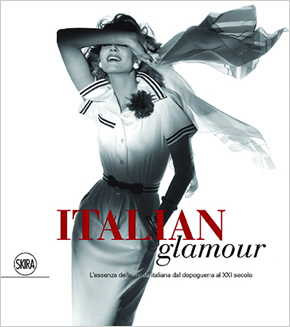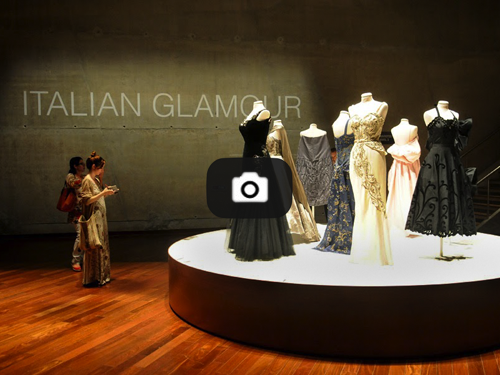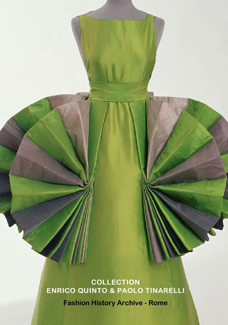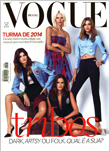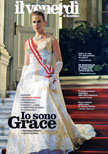-
THE 50s:
The craftsman and folklore: the land as muse
Breaking free from French cultural hegemony
Defining Italian Fashion: Florence 1951
Hollywood on the Tiber
The "Pretino" of the Sorelle Fontane
THE 60s:
The Palazzo Pyjama
The allure and the exotic in Roman High Fashion
Double Face fabric
THE 60s - 70s:
The designer: from Boutique to Prêt-a-Porter
THE 70s:
The great age of print
The woman: Wamp or Androgenous?
From Chemisier to Tailleur
THE 80s:
The apex of "Made In Italy"
Fashion and Design
Postmodernism
The declaration of Luxury
Roberto Capucci
To be is to appear
THE 90s to THE NAUGHTIES:
Excess and understatement in a global phenomenon
Minimalism and the poetry of "Vintage".
-
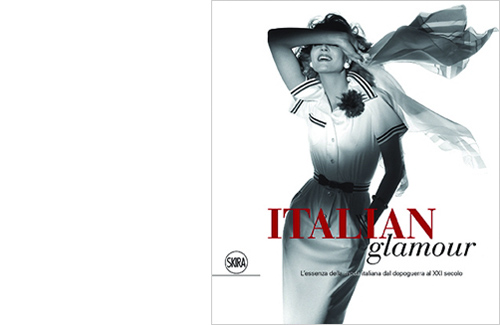
-
ITALIAN GLAMOUR is an exhibition of Italian fashion from the immediate post-war period to the present day
ITALIAN GLAMOUR represents those specifically Italian elements in the Quinto Tinarelli International Fashion Collection which consists of six thousand pieces from the twentieth and twenty-first centuries
ITALIAN GLAMOUR with a selection of 150 garments, characteristic of Italian style, has been exhibited from 7th april to 6th of july 2014, at the Cidades das Artes, Avenida das Americas 5300, Barra da Tijuca, Rio de janeiro
-
-
The exhibition will be a melange of items from just after the war right up to the present day, divided according to theme. The idea of departing from a purely chronological sequence springs from a desire to demonstrate the vitality and ongoing relevance of historical pieces through their juxtaposition with contemporary examples.
The date and provenance of each piece will be made clear with unobtrusive note cards.
We have chosen two timeless pieces to introduce the whole story of italian fashion from the post-war period to the present day.
FIRST ENTRANCE
A Myricae dress from 1957 of hand painted sackcloth will serve to introduce a room dedicated to themes relating to the land itself: the importance of craftsmen and women, the use of materials such as raffia or ceramics, the emergence of casual wear, the significance of the textile industry, boutique fashion; all are elements derived from a more casual and practical way of life which gained international fame through holiday destinations like Capri, Positano and Portofino. Amongst the dramatis personae in this story we find such names as Emilio Pucci, Roberta di Camerino, Gucci and Ferragamo.
From this room which presents the beginnings of boutique fashion we progress to another area and unravel the process of evolution from this stage to that of Alta Moda Pronta and prêt-a-porter; fashion which through the seventies and eighties, thanks to the extraordinary talents of certain designers, gradually produced a sort of consecration of "Made In Italy" and put Milan at the forefront of the global fashion scene.
Amongst these talents were those of Missoni, Krizia, Giorgio Armani, Walter Albini, Roberto Cavalli, Gianfranco Ferré, Gianni Versace, Luciano Soprani, Enrico Coveri, Laura Biagiotti, Gianni Versace, Romeo Gigli, Dolce e Gabbana, Anna Molinari, Alberta Ferretti, Prada, Fendi, Trussardi , Moschino, Max Mara and many others.
Representatives of the new generation will also appear in this context, names such as Giambattista Valli, Maurizio Pecoraro, Maurizio Galante, Gaetano Navarra and Sergio Zambon.
This room will be connected with an area devoted exclusively to Roman Alta Moda, divided into three sections.
SECOND ENTRANCE
The trail begins with the famous "Pretino" of the Sorelle Fontane. It was a dress created for Ava Gardner and then immortalised through having been worn by Anita Ekberg in the film La Dolce Vita by Federico Fellini.
This piece is an example of those elements in Italian culture which stem from its Catholic and aristocratic origins.
It opens the window to a selection of black exhibits in which the dramatic effect of total black serves to heighten the emotional impact and elegance of each piece.
In this context items of different eras are compared and contrasted whether in the sphere of High Fashion or Prêt-a-Porter.
From total black we progress to an environment focusing exclusively on pastel colours.
These two installations not only describe a defining moment in the emergence of Italian fashion in 1951 in the Sala Bianca of the Palazzo Pitti in Florence but also communicate the atmosphere of the Roman Dolce Vita, an era in which style itself took its lead from the great actresses, when Cinecittà became known as "Hollywood on the Tiber".
Out came the work of the Sorelle Fontane, Emilio Schuberth, Carosa, Simonetta, Maruccelli, Ferdinandi, Vanna, Ferrario, Capucci, Gattinoni, Biki di Veneziani, amongst many others.
This room introduces us to an area, mentioned earlier, dedicated to High Fashion of a specifically Roman character.
An initial space is devoted to a specific development in taste which tended to the exotic.
The seventies were concerned with a kind of theatrical fashion, having oriental echoes, which evoked the experiences of the Jet Set. For this reason the section is dedicated to the so-called "Beautiful People" and to those Italian beauties whose images filled the magazines and newsreels of the time.
Here are found various pieces from the Palazzo Pyjama of Irene Galitzine, truly a revolutionary development in female costume in that it assented to the use of trousers as an expression of feminine elegance.
Other articles belong to Emilio Pucci, Valentino, Forquet, Angelo Tarlazzi for Carosa, Simonetta and Fabiani.
A second space focuses on daywear pieces and on such innovations as double faced fabric which became an almost exclusively Italian prerogative. Here we have the creations of Mila Schön, André Laug, Fabiani, Valentino, Forquet, Lancetti and others.
The third space is also concerned with the importance of a particular development in Italian High Fashion: printed fabric. Chiffon dresses from wide-ranging imaginative viewpoints display the work of Lancetti, Renato Balestra, Sarli, Barocco and Valentino.
This last section reconnects with the one devoted to the story of prêt-a-porter.
A homage to the unique talent of Roberto Capucci will be presented showing ten of his sculptural dresses in a central area of the exhibition.
More Website Templates @ TemplateMonster.com. May 07, 2012!



